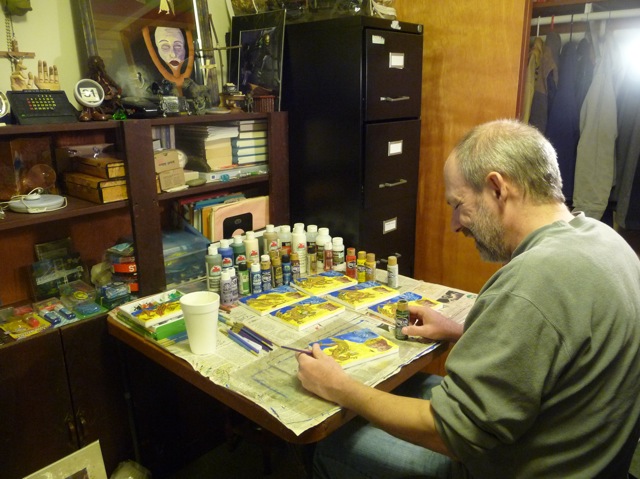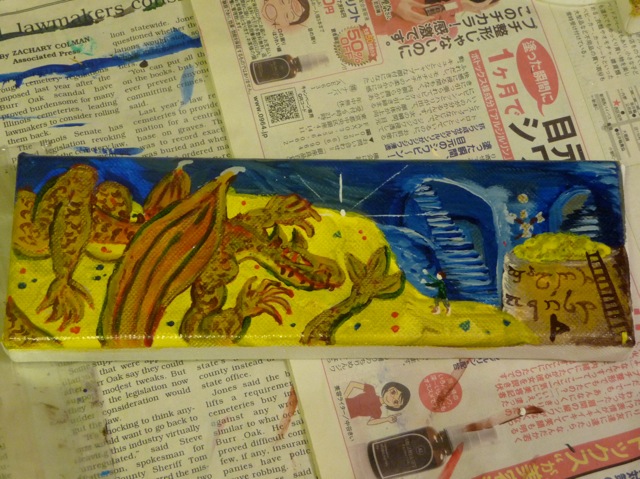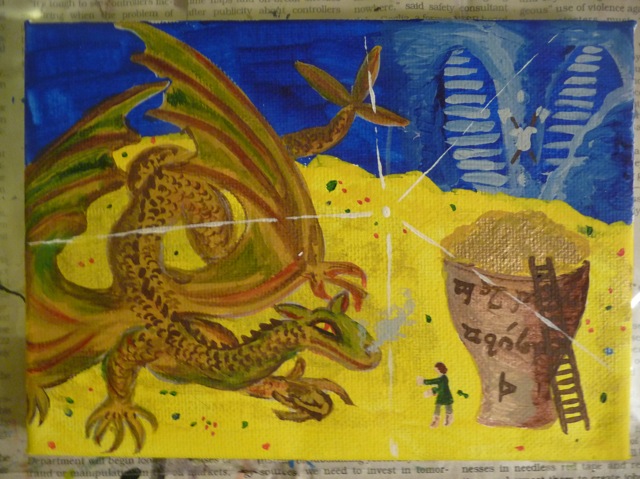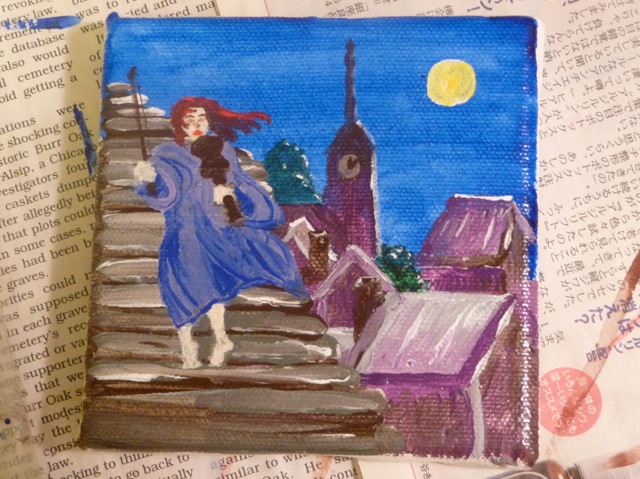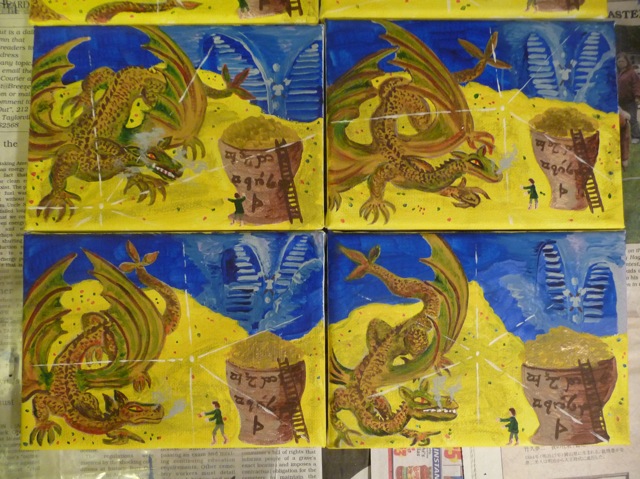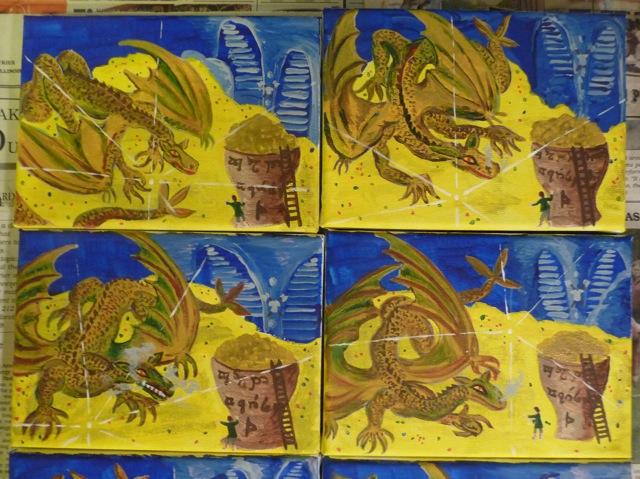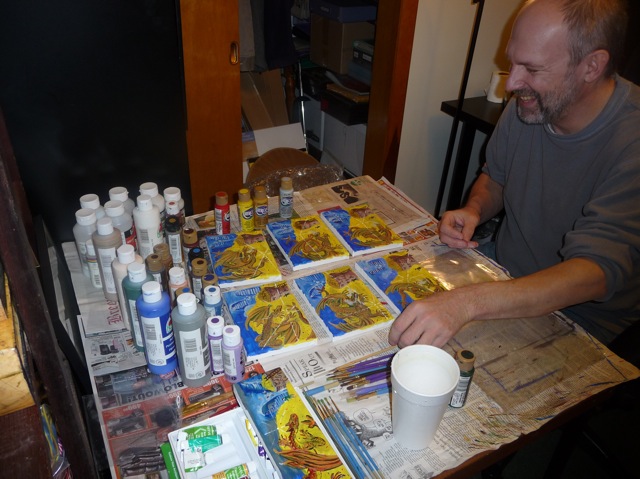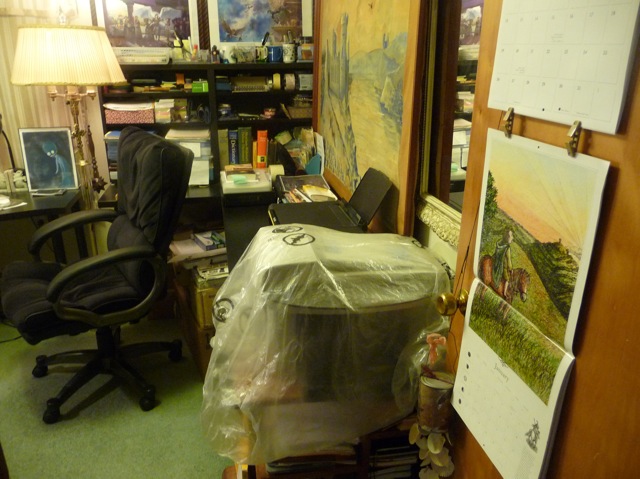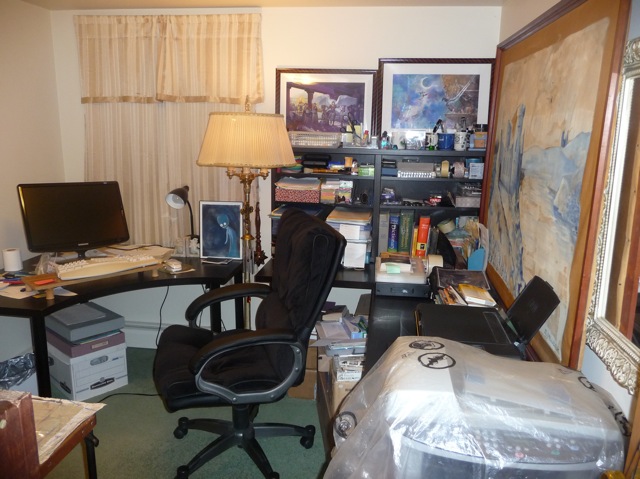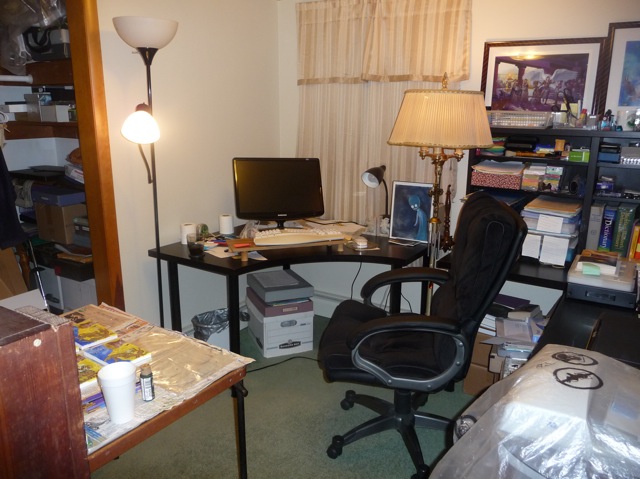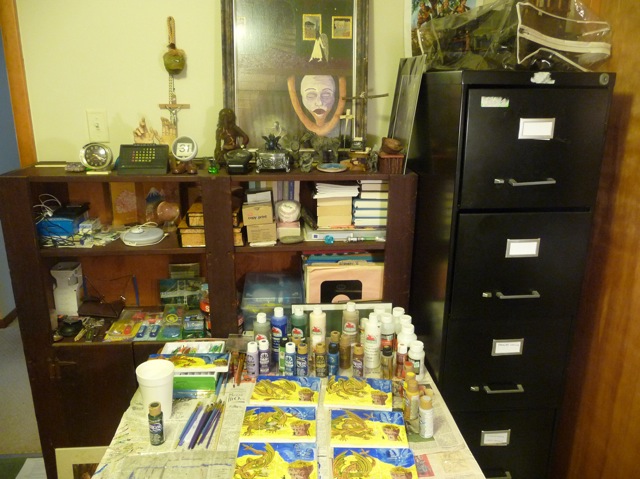It began with a shopping trip to Michael’s, the craft-supply store. We were there just before Christmas to get some picture frames. I, of course, wandered into the art section to admire the paints, brushes, and canvases. Well, you know how the tools of the trade can call out to any artist — keyboards, monitors, notebooks, and pens entice writers to write. The same is true of painting stuff. A stack of some miniature canvases called out to me, and suddenly I had an inspiration for some unique Christmas presents I could hand-make.

Bilbo and Smaug, Christmas and New Year Season, 2013-2014; acrylic on canvas, Frederic S. Durbin; this was the first I did of the later, larger set. Smaug’s back legs here are strangely human. Unique to this pose is that Smaug appears to be jealously guarding the Arkenstone, almost clutching it.
Yes, from the end of December through January, the Man Cave at our place became my painting studio. As I’ve said before, painting makes a really enjoyable diversion for me, because there’s no pressure to be any good at it. I know I have no particular talent and no training. I can just experiment and have fun immersing myself in the story-world of painted images.
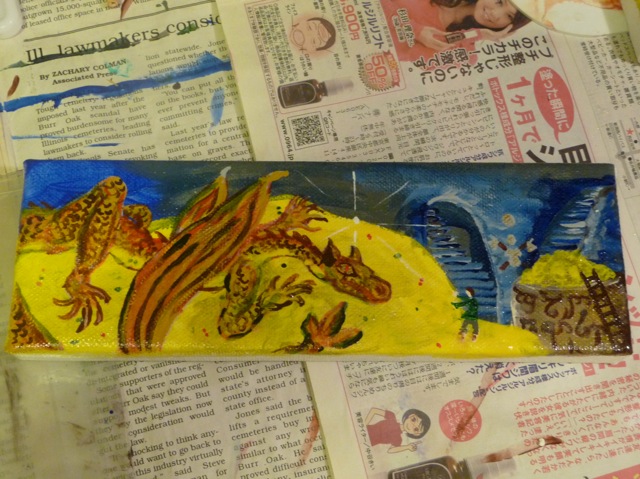
This was the very first one of the bunch I painted (my initial set was done on smaller, longer, less tall canvases as you see here). I like the serpentine look of Smaug. In this one, I wish I’d placed Bilbo a step farther forward, so that he would be against the background of the treasure-pile rather than the dark stairway. I see there are still some Japanese newspapers among my favorite art supplies!
Please bear in mind that these are close-up images of small canvases (you can get an idea of size from the newsprint visible); so at this magnification, they look blurrier than when you see them for real, displayed, etc.
These paintings are based, of course, on J. R. R. Tolkien’s Conversation with Smaug, which he did in pencil, black ink, watercolor, and possibly colored ink — the last of his Hobbit watercolors. Tolkien described Smaug as “a serpent creature . . . 20 ft or more.” You can easily Google Tolkien’s painting if you’re not familiar with it.
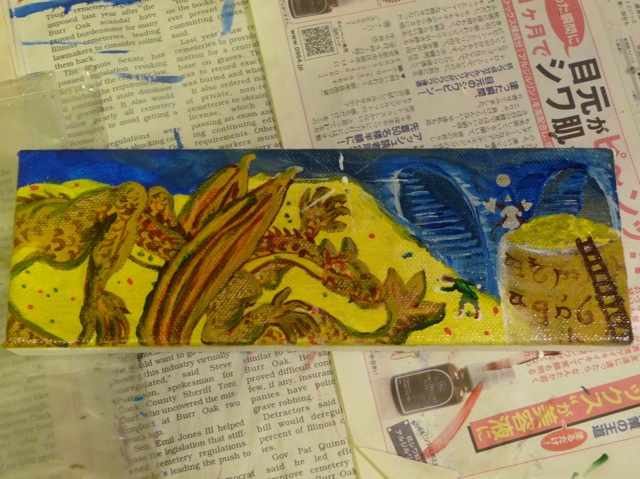
Another of the smaller canvases, the first set. Here, the Arkenstone is atop the treasure-hoard. Bilbo is bowing, as in Tolkien’s version. Tolkien chose to show Bilbo’s ring-induced invisibility by drawing him all black, like a silhouette, and putting him inside a cloud. I chose to go with more realistic colors for Bilbo, as he would look to himself (as far as we know) while invisible. Tolkien makes the point of telling us in the text of the story that Bilbo only figured out he was invisible when wearing the ring by the reactions of others, who couldn’t see him.
The various elements in the paintings are all imitated directly from Tolkien’s picture: the armor and weapons affixed to the wall, the stairways descending from above and entering the treasure-hall through archways, and the vat of gold accessed by a tall ladder leaned against it. This ladder seems an impractical arrangement for anything other than simply admiring the gold in the urn; but I suppose admiring is, after all, mostly what the dwarves did with it. The Elvish tengwar letters on the urn spell out a curse directed against thieves.
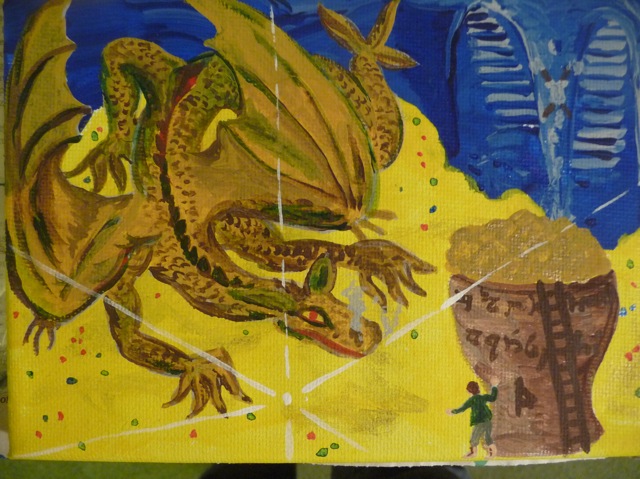
This is the second of the larger painting series. I’m fond of the realism of Bilbo’s pose in this one. With this image, I began to add the smoke curling from the dragon’s nostrils. Like Tolkien did, I used warm colors for Smaug with hints of green, suggesting both his fire-breathing nature and his reptilian aspects. In Tolkien’s picture, Smaug’s wings look too small to me, so I made them bigger. The challenge in composition is in having big wings that don’t block our view of Smaug. In this pose he’s kind of all over the place, a sprawl of wings and limbs; I think he’s in motion, crawling.
I like the basic composition of all these paintings. The deep blues of the mountain’s interior serve as a nice backdrop for the brightness of the treasure-pile — which, in turn, nicely highlights Smaug, making him clearly visible in all his glory. There are just enough other elements — the mail-shirt on the wall, the treasure-urn — to be interesting without cluttering the canvas or distracting us from the two characters. The urn gives Bilbo a prop to interact with, to partially hide behind in some of the poses.
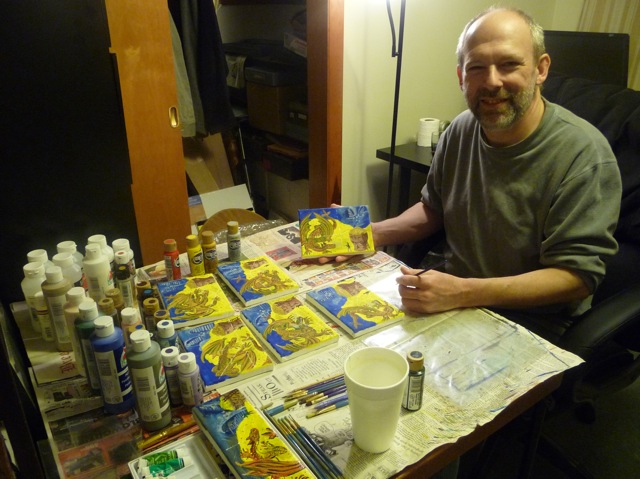
Acrylic is the most forgiving artistic medium I know. There’s no mistake you can make that you can’t paint over, and pretty quickly, at that. As things dry, they tend to look better than you thought they would. If you just keep after an element until you’re satisfied with it, you can usually come up with a painting you like. Whether it’s wise or not, I generally do most of my mixing and blending right on the canvas, as I’m coloring and shading the image.
You can probably tell that the kingdom of Erebor itself is my favorite part of these paintings. I love those dim stairways deep beneath the mountain . . . those passages receding into long-abandoned, echoing halls . . .
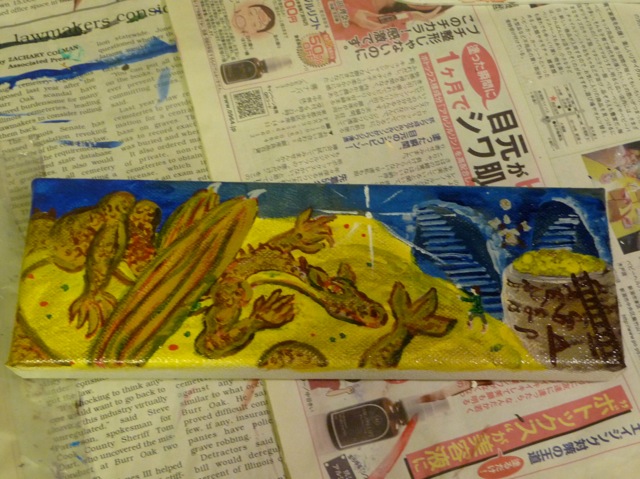
“Smaug lay, with wings folded like an immeasurable bat . . . Behind him where the walls were nearest could dimly be seen coats of mail, helms and axes, swords and spears hanging; and there in rows stood great jars and vessels filled with a wealth that could not be guessed.” — J. R. R. Tolkien, The Hobbit
Smaug’s fleur-de-lys tail is Tolkien’s idea. In none of these did I manage to paint it as slender and graceful as it appears in Tolkien’s picture.
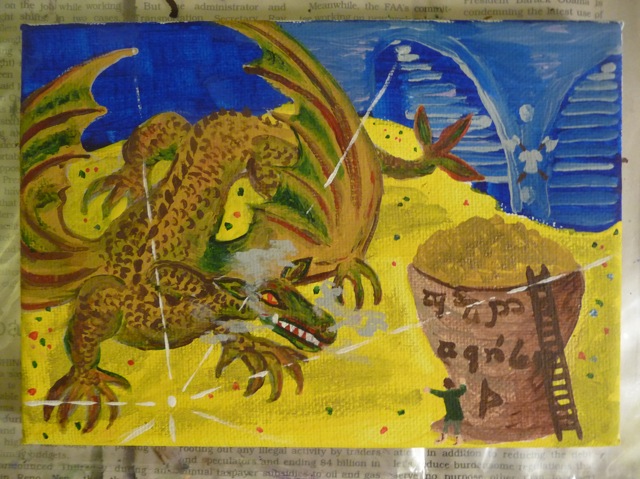
Thick, muscular Smaug. He’s less a worm here, more of a farmyard animal, like a cow — though the wreath of smoke almost suggests that his head is swinging about. The Bilbo is my favorite part of this one.
‘”Revenge!” he snorted, and the light of his eyes lit the hall from floor to ceiling like scarlet lightning. “Revenge! The King under the Mountain is dead and where are his kin that dare seek revenge? Girion Lord of Dale is dead, and I have eaten his people like a wolf among sheep, and where are his sons’ sons that dare approach me?”‘ — J. R. R. Tolkien, The Hobbit
‘Beneath him, under all his limbs and his huge coiled tail, and about him on all sides stretching away across the unseen floors, lay countless piles of precious things, gold wrought and unwrought, gems and jewels, and silver red-stained in the ruddy light.’ — J. R. R. Tolkien, The Hobbit
‘Before him lies the great bottommost cellar or dungeon-hall of the ancient dwarves right at the Mountain’s root. It is almost dark so that its vastness can only be dimly guessed, but rising from the near side of the rocky floor there is a great glow. The glow of Smaug!’ — J. R. R. Tolkien, The Hobbit
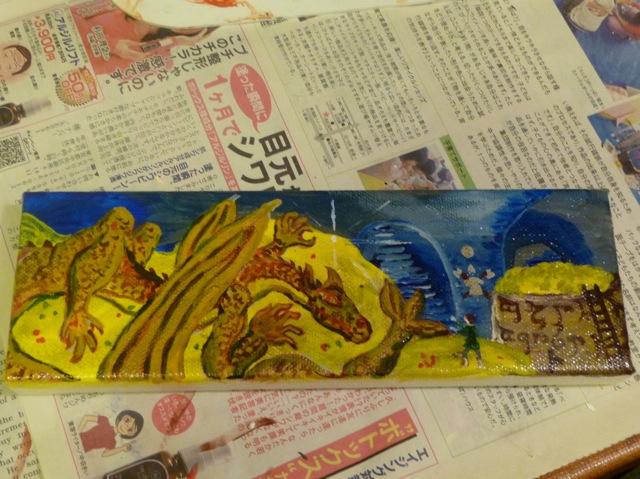
I really like the back half of Smaug here — the hind legs and the very reptilian-looking rear claw with fingers of unequal length. Pretty huge treasure-urn!
I really had fun working on these, mostly late at night during the holidays. As presents, they mostly arrived late. That’s what happens when you don’t get the idea for them until the last minute.
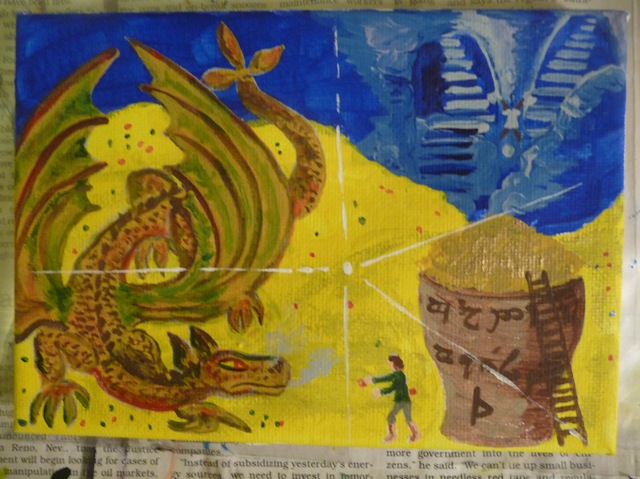
This is the one, out of all of them, that we chose to keep for ourselves. Independently of each other, we both liked it the best (though there was some aspect of each painting that I liked better than all others). This is the one that we thought best suited us overall, considering all the elements. Julie says it looks like an icon of the scene (in the Orthodox Church sense)! I love the stairways. Bilbo is quite lanky here! I like the S-curve of Smaug’s body. [Our second-favorite — again, in independent selection! — was the one up at the very top of this post, the “human-back-legs Smaug” — so we kept that one in the family; it went to my Cousin Phil!]
Julie says that painting must be set in Pittsburgh, because there’s an outdoor stairway on a hillside above a village!
And one more version of the conversation with Smaug:
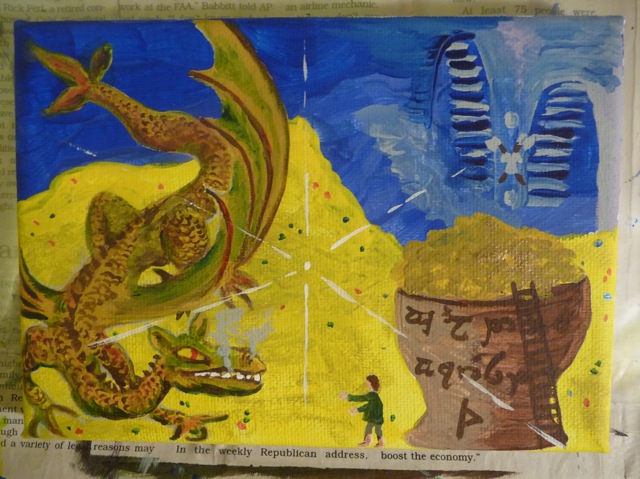
This is the most Asian-looking Smaug of the bunch. This was the last one I did out of all, small and large. By this time, I was really getting the shading and motion of the dragon’s body the way I wanted it.
Incidentally, the order of painting was this: I laid in the halls of Erebor, then unfurled the mound of treasure. Then I did all the treasure urns — I’m talking factory-style here — all the urns on all the canvases, before any of the set of paintings was finished. So for a couple weeks, I just had pictures of dwarvish halls and treasure-vats and gold piles on my table. Then I did all the dragons, and usually the ladders at about this point. Finally, I put in Bilbos. The Arkenstone was the last element in each painting.
Here’s a last look at the bigger canvases, so you can compare various poses side-by-side:
Good times!
And here I am again:
And the Man Cave itself:
My desk:
Another angle:
And that great file cabinet from Construction Junction:
“If there really is a dragon down there, laddie . . . don’t wake it up.” — Balin
God bless the storytellers who work in every medium, and those who love them!
